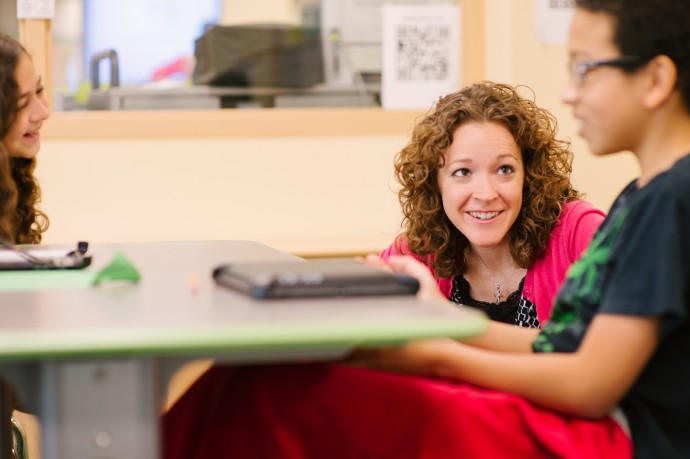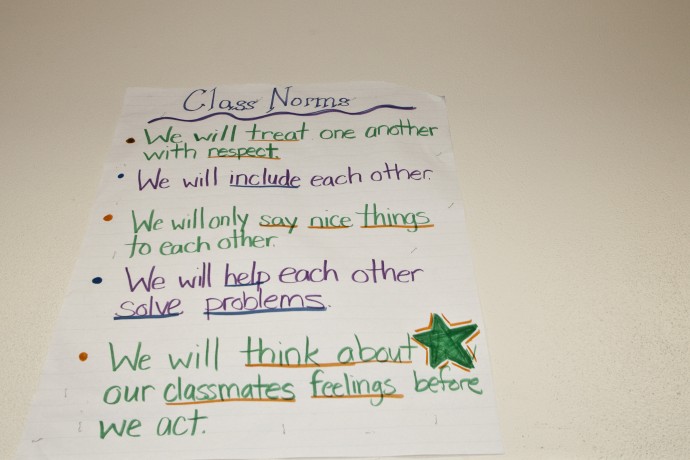This is Part 4 of the 5-part Identity Safety Blog Series, a partnership project of Not In Our Town and the Center for the Collaborative Classroom (CCC). Watch the companion webinar to this collaborative series.

By Dr. Dorothy M. Steele
Positive classroom relationships are the foundation of an identity safe classroom. You cannot create a sense of identity safety without a continuous focus on how the students are feeling and treating one another. Positive classroom relationships are based on trusting, positive interactions with the teacher and among the students.
Think about all the teachers you had in school. What jumps out? My co-author, Becki Cohn-Vargas, immediately remembered Mr. J., a creative writing teacher who nurtured her as a writer. She also remembered Miss K., who wrote in her journal (one she still has to this day—50 years later) I can’t wait to see you in print. But she also remembers Ms. H., who humiliated her in front of her entire sixth-grade class. Trust gets built through many micro-interactions that build over time. It is the feeling a student has that “my teacher believes I can do this and will stand by me as I work to get there.”
Building positive classroom relationships involves two identity safety components: teacher warmth and availability to support learning, and positive student relationships.
The component of teacher warmth and availability to support learning connects the academic and social aspects of teaching. When teachers show their students warmth and personal connection, students feel their teacher knows and appreciates them and their efforts as students. They know they “can do it!”
Teachers demonstrate their availability to support student learning when they are sincerely engaged in the academic work themselves, are responsive to student needs, and encourage students to seek help when they need it. This shows the students that learning is a process of effort, practice, revision, and support from others. The focus in the classroom is not just on getting the right answer, but on fully engaging in the process of learning.
A few simple things make a lot of difference to students:
- Use words thoughtfully. For example, even when you need to give students difficult feedback, make sure you understand what they were doing, and be encouraging as you ask them to rethink and revise their work.
- Send a positive call, note, or e-mail home. One parent remembers clearly the teacher who said, “I am so happy to have your son in my class, he has such an inquisitive mind and contributes so much.” That teacher did not know how much it meant to that parent, whose son was having trouble in school at the time.
- Connect with each student daily. Find the unique ways that each child contributes, and give them more opportunities to do so.
- Turn mistakes into learning opportunities. One math teacher would have the kids analyze their mistakes. When she asked them to share what they discovered, all their hands shot up. Mistakes were safe to make in that classroom.
- Learn and teach your students a few words in the language of each English Language Learner in the class. Giving students opportunities to share their home language lets them know they matter to you.
- Monitor and support student engagement. By regular observation, you may realize that one student needs extra time to finish her work. Or, you may ask one student to help another so both of them will improve their understanding of the task. Always try to give negative feedback privately.
The next identity safety component, positive student relationships, builds interpersonal understanding and caring among students. The environment should be focused on empathy and free of bullying. Extend your involvement beyond the classroom door. What is happening on the schoolyard or on the way to and from school? And who is included and who is left out of birthday parties and playdates?
- Create norms for the classroom that address not only behavior, but also respect and empathy. Help students learn to understand their own feelings. Perspective-taking activities help students consider how others feel.
- Pay attention to how students interact with each other. Who is dominating? Who is left out? Teachers can be very intentional about grouping students. First, teach students how to work together by practicing with simple group activities. Then, give them opportunities to work together in pairs and small groups on a regular basis, mixing up the groups and watching how they work together.
- Help create a sense of belonging inside and outside the classroom. For example, watch the students at recess. What are they doing? Is a boy off by himself, or is a girl sitting alone at lunch? Discuss with the students ways to be inclusive in their games. One after-school coordinator in a school with mostly Latino students noticed that the students were telling white and black children that “only Mexicans could play soccer.” She made a point to have a discussion with all the students about how the field and games were for everybody. They worked together to come up with ways that all students could play.

Helping students build positive relationships with you as their teacher and with their peers not only creates a sense of belonging and identity safety, but also gives them lifelong skills that will help them with their families, friends, and future careers.
This blog is part four of a five-part series on identity safe classrooms. You can read the introduction to this series here.
This blog was co-authored by Becki Cohn-Vargas, EdD. Becki is co-author of the new book Identity Safe Classrooms: Places to Belong and Learn, and director of Not In Our School, designing curriculum, coaching schools, and producing films and digital media on models for creating safe and inclusive schools, free of bullying and intolerance at national nonprofit the Working Group. She also teaches online courses on bullying prevention for the University of San Diego. Becki worked in educational settings for over 35 years as a teacher and administrator.
Dorothy M. Steele, EdD, is co-author of the new book Identity Safe Classrooms: Places to Belong and Learn, and former executive director of the Center for Comparative Studies in Race and Ethnicity at Stanford University. She is an early childhood educator who is interested in public schools, including teaching practices that are effective for diverse classrooms, alternative assessment processes that inform teaching and learning, and strategies that build inclusive communities of learners in schools. Her work with the Stanford Integrated Schools Project was an attempt to look at these various aspects of schooling in a large urban school district.
Add new comment